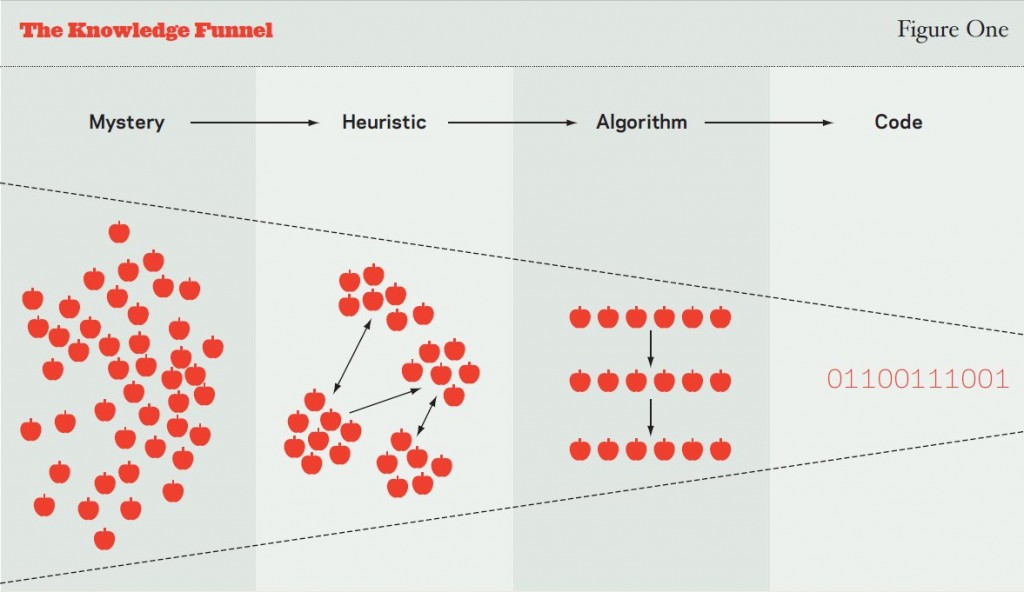
by Braden Kelley
Previously I explored the value of eminence and thought leadership to consulting firms, and how unfortunately the power of inbound content marketing has a dark side that forms part of a three-pronged attack on the consulting industry.
Meanwhile, the tireless invention and innovation efforts of research teams in companies around the world have helped to keep the pace of technological advancement in computer processing power at or above Moore’s Law for several decades. This has given technology companies the ability to put more computing power than the entire Apollo space program into the pockets of more than a billion people around the world.
It seems like everything has become digital, including music, books, and even movies. Increasingly intelligent digital technologies and mercurial customer expectations threaten both people and enterprise at every turn. With all of this technological change, the last few decades have been an amazing time for consultancies, full of revenue and opportunities. Clients desperate for solutions to help them cope with these challenging times helped management consulting firms grow in size and scale, expanding to cover multiple technology, and even marketing, specialties.
But the same technologies that have led to the growth of consulting companies over the last couple of decades, will begin to lead to a shrinking of those same consulting firms. The increasing diversification of the large global consultancies into other specialties is the first step to what is an inevitable shrinkage forced upon the industry by the three factors I detailed in my last article titled Consulting Industry Caught in the Crossfire.
The same forces that are causing a feeling of disequilibrium for the firms that consultancies serve are also causing the same unease, trepidation and challenge for the consulting firms themselves as they find themselves attacked on three sides from:
1. Increasingly Available Intellectual Property
2. Internal Consultants
3. Artificial Intelligence
In my previous article on the Consulting Industry Attacked on Three Sides I looked at each attack in turn, but in this article I would like to dig a bit deeper into the final threat.
Artificial Intelligence
Roboadvisors, chatbots, and other implementations of artificial intelligence have captured people’s imaginations and led to both an increase in the number of articles written about artificial intelligence, but also in the practical implementations of artificial intelligence. People are becoming increasing comfortable with artificial intelligence thanks to the recommendation engines on Amazon and Netflix and IBM Watson’s appearance on the game show Jeopardy and battles against chess grandmasters.
But what does consulting have to fear from artificial intelligence?
Perhaps viewing this short video might give you a glimpse:
In the short run, maybe consultants don’t have as much to fear from artificial intelligence as workers in transportation, retail, or manufacturing. But, in the grander scheme of things, over time enterprising technology vendors will inevitably build upon publicly available artificial intelligence frameworks made publicly available by companies like Microsoft and Google (who are seeking to increase the sale of cloud services) to automate some of the tasks that recently minted undergraduate analysts or Indians perform now for the large consulting firms.
What we are starting to see is exactly what Roger Martin described in his landmark book The Design of Business, from which I would like to highlight one of the key concepts called The Knowledge Funnel highlighted in the image from the book below.
 Source: The Design of Business by Roger Martin
Source: The Design of Business by Roger Martin
The key point here is that as we understand our business and our interactions with our customers well enough, what was once a mystery we start to identify patterns inside of (heuristics), which then eventually allows us to create algorithms that can be captured in Standard Operating Procedures (SOP’s) and then eventually in code. The power of artificial intelligence is the ability to move the role of the machine to the left in The Knowledge Funnel, away from pure manual coding by a human, to computer programs that write themselves and eventually to heuristic identification and algorithm creation at some point in the near future. This is what crowd computing, machine learning and deep learning ultimately make possible, and which I explored in a previous article titled Welcome to the Crowd Computing Revolution in more detail. The fact remains that as computer programmers and the artificial minds they create become more adept at watching the work that consultants do and recognizing the patterns in their recommendations, the pressure on consultancies will build.
Conclusion
These are challenging times for large consultancies and small independent consultants as consultancies are forced respond to these attacks from three sides. Part of that three-pronged attack will come from a growing legion of automation engineers taking to cubicles around the world to design people out of jobs. In the same way that mechanical engineers build robots to replace our human muscles with machine muscles, automation engineers are computer programmers tasked with creating inexpensive machine minds with sufficient artificial intelligence to replace our more expensive human minds. Professions like that of the automation engineer will attract increasing numbers from workforces around the world, but not nearly enough to offset the losses in job opportunities that these individuals are tasked with eliminating. Only time will tell how quickly and how broadly artificial intelligence (AI) threatens the core business of consultancies.
If you are in the consulting industry, what is your strategy for responding to this threat?
Because, make no mistake, the threat is real. The only question is how quickly it will materially impact your bottom line.
BONUS:
You might enjoy this interview with David Cope, the creator of Emi (Emily Howell) the algorithmic composer, whom he later killed:
![]() Sign up here to get Human-Centered Change & Innovation Weekly delivered to your inbox every week.
Sign up here to get Human-Centered Change & Innovation Weekly delivered to your inbox every week.



 Consulting firms sell expertise, and their currency is trust. Large consultancies like Boston Consulting Group, Bain, McKinsey, Deloitte, Accenture and others make their money from being a trusted advisor to companies around the world. Why do companies trust them?
Consulting firms sell expertise, and their currency is trust. Large consultancies like Boston Consulting Group, Bain, McKinsey, Deloitte, Accenture and others make their money from being a trusted advisor to companies around the world. Why do companies trust them? After working for the last decade helping organizations from the OUTSIDE IN:
After working for the last decade helping organizations from the OUTSIDE IN: